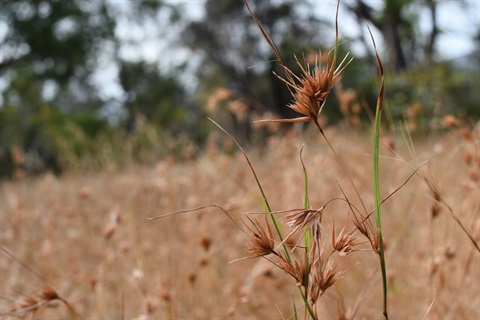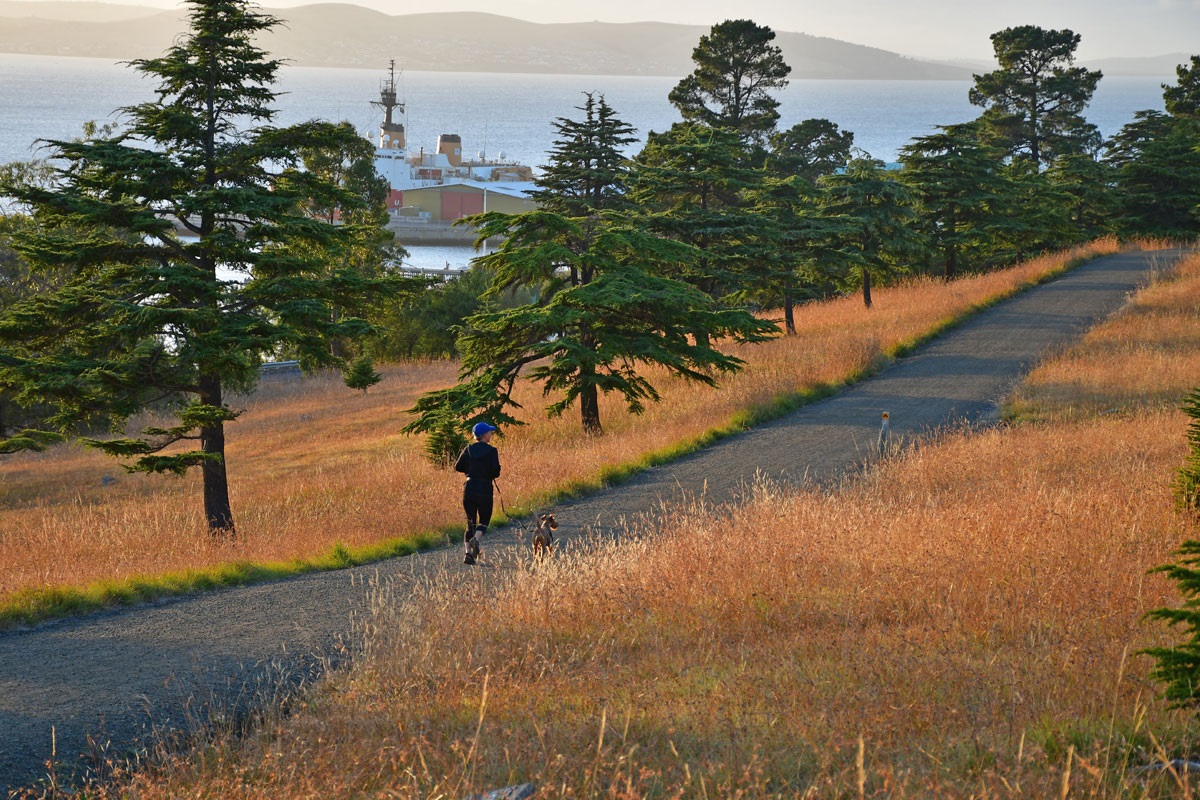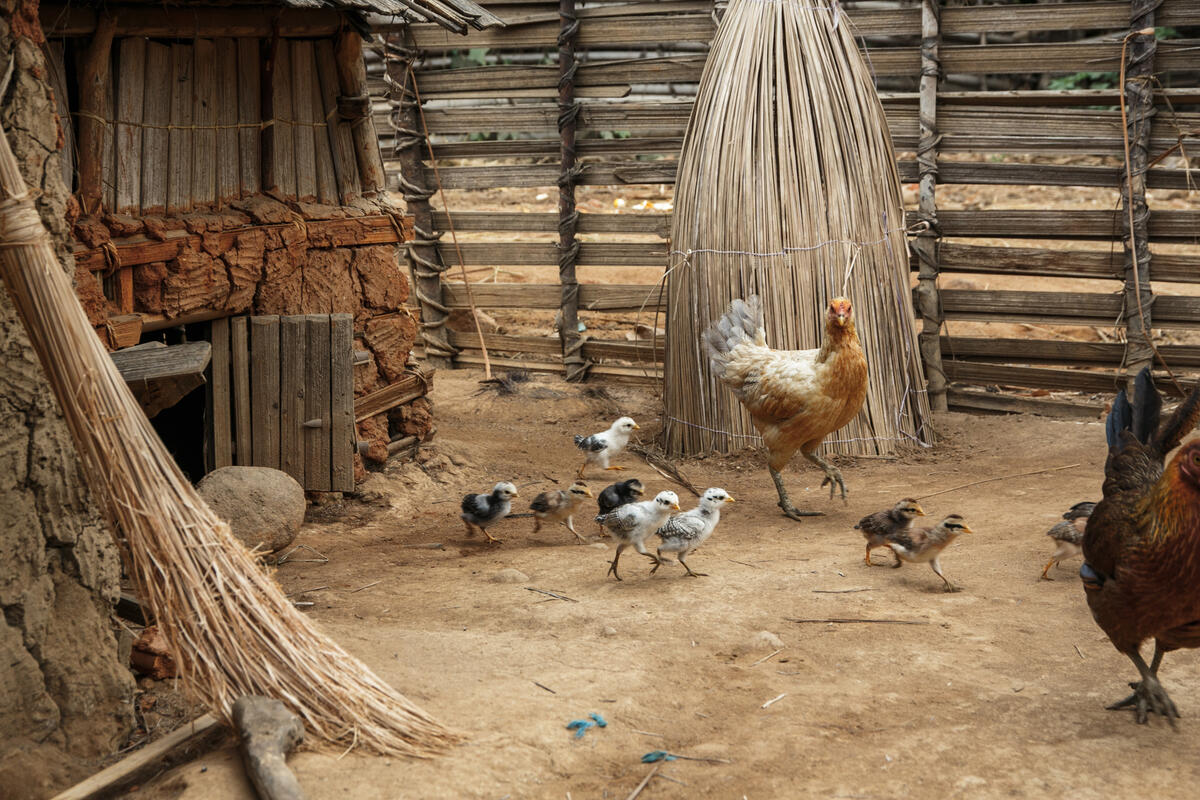
Looking up towards the summit of the Queens Domain travelling southeast along the Brooker Highway, a distinctive streak of gold can be seen snaking between dense vegetation in summer.
A sweep of kangaroo grass (Themeda triandra) dominates the north face of the hill, its summer flush of deep-gold seed heads staking out a patch of remnant grassland in the heart of Hobart.
Formerly widespread, the Domain’s critically endangered lowland Themeda triandra grasslands once formed vast mosaics of Muwinina-managed country, shaped by fire and cared for over millennia. Today, these ecosystems are limited to small fragments situated north of Hobart and into the Midlands, where they face complex and constant threats.
Development, weeds, climate change and altered fire regimes have had deep effects on grasslands and grassy woodlands such as the Queens Domain, but a joint effort by the City of Hobart and the University of Tasmania’s Professor Jamie Kirkpatrick is bringing this grassland back from the brink.
A dramatic history
The Queens Domain has seen some dramatic landscape changes over the years. The removal of traditional fire management paved the way for weeds, shrubs and small trees to begin their slow march across the grassland. Without regular burning, slashing or grazing, shrubby seedlings shaded out the Themeda and shouldered in on the inter-tussock spaces usually occupied by orchids, daisies, lilies and twining pea flowers. Drooping sheoak (Allocasuarina verticillata) gradually closed in on the grasslands, changing their structure to form a dense canopy with little else underneath.
Although naturally occurring on the Domain, sheoaks can quickly grow out of control. The fallen sheoak branchlets form a dense mat that prevents undergrowth from developing. In the 1930s and 40s, there was a brief reprieve from the Allocasuarina invasion when large stands were sawn down and hauled out to fire up the ovens of bakers in town. Within a couple of decades, however, the Queens Domain was largely dominated by this species.
The dramatic change to vegetation structure on the Queens Domain has been the subject of a long-term study by UTAS Professor Jamie Kirkpatrick. Documenting vegetation change in the Domain’s grassy woodlands since 1974, Professor Kirkpatrick’s remarkable research has guided restoration efforts on the Domain for decades.
His documentation showed sites of high conservation value within the grasslands were markedly declining as the sheoaks advanced.
“One of the major problems in maintaining rare plant species on the Domain is that most of them do not like thick litter from sheoaks or competition from kangaroo grass, so are now surviving under exotic cypresses,” Professor Kirkpatrick says.

Rare remnant species
The Soldiers Memorial Avenue, which is regularly slashed, holds some of the Domain’s rarest remnant species. It was understood in the early 90s that the City of Hobart’s fire regime would need to be frequent and regular to suppress the spread across the rest of the reserve. Mature sheoaks and their dense carpet of needles prevented prescribed burns from getting hot enough to be effective, and larger trees were surviving the burns unscathed – burning alone was not enough to progress the Domain’s restoration.
The City of Hobart’s current integrated approach of mechanical thinning and periodic burning has made significant headway in the ecological restoration of the grassy woodlands on the Queens Domain.
The City’s Fire and Biodiversity Team and Bushcare volunteer crews have been working hard to keep sheoak numbers in check.
By freeing up space around the white gum (Eucalyptus viminalis) and blue gum (Eucalyptus globulus) saplings surviving among the sheoaks, these young trees will have enough space, light and nutrient to put on growth and become resilient canopy trees.
It takes approximately 100 years for a tree to begin forming hollows, so these saplings will one day create critical habitat for swift parrots, pardalotes, masked owls and other hollow-nesting species.
Where sheoaks have been removed, the lowland grasslands have been quick to return. According to Professor Kirkpatrick, “the wallabies and pademelons now on the Domain are also doing their bit, while the bandicoots create regeneration niches”.
A walk along the Joggers Loop today will take you past elbow-high speargrasses where thick sheoak once stood. The grasslands’ purple and yellow wildflower palette is gradually coming back – Dianella lilies and delicate button flowers dot the grassy understorey.
Grasslands have evolved over time under complex management regimes, and caring for them in the face of a changing climate will be no easy task. The City of Hobart’s longest-running ecological restoration project is far from over.







